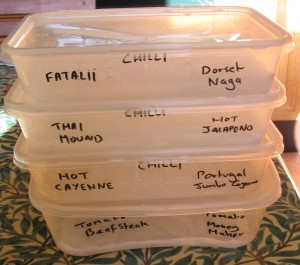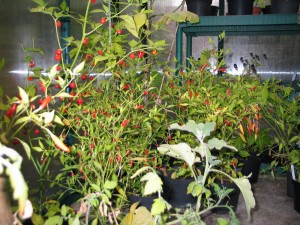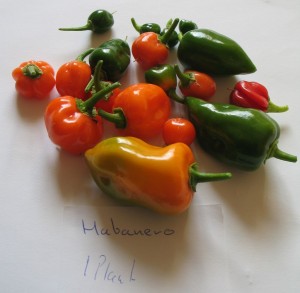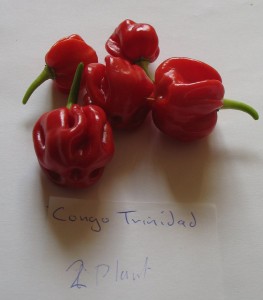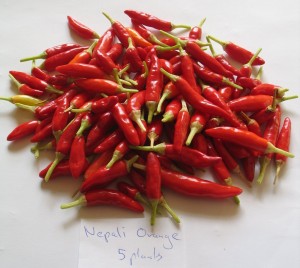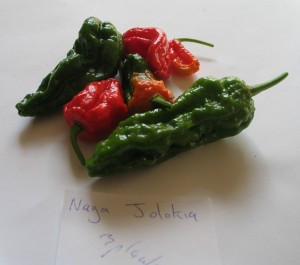OT: Chillies for 2013
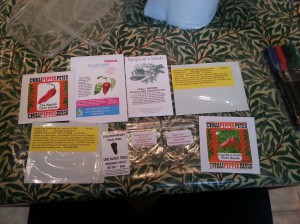 I’ve sown my seeds for this year and have decided to document the process on G+ for a change.
I’ve sown my seeds for this year and have decided to document the process on G+ for a change.
So if you want to find out about what I and other chilli heads will be growing this year head over to the Chillies Community on Google Plus…
OT: Chillies 2012
It’s that time again.
This evening (Saturday 21/01/2012) I have sowed 13 varieties of chillies, just over 50 seeds! I’m very excited about the prospects for the year ahead but have absolutely no idea what I will do if I have 50 plants to tend – they won’t all fit in our small greenhouse and we don’t have a conservatory… Suggestions welcome.
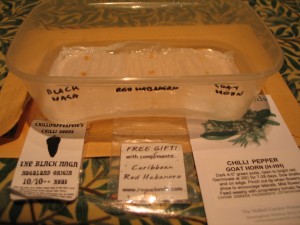 From the left there is “Black Naga” which I managed to grow last year and by the end of October the pods had ripened to a dark chocolate brown colour. They were hot too 🙂 . Next is a Red Habanero – These seeds were a gift from my sister-in-law and I have no idea what they will be like but Habaneros are generally quite hot and a have lovely fruity flavour. Finally in this tray is Goat Horn which I also grew last year and they were an absolute delight! A lovely traditional torpedo shaped chilli with a great flavour. They aren’t blisteringly hot but a very, very nice chilli.
From the left there is “Black Naga” which I managed to grow last year and by the end of October the pods had ripened to a dark chocolate brown colour. They were hot too 🙂 . Next is a Red Habanero – These seeds were a gift from my sister-in-law and I have no idea what they will be like but Habaneros are generally quite hot and a have lovely fruity flavour. Finally in this tray is Goat Horn which I also grew last year and they were an absolute delight! A lovely traditional torpedo shaped chilli with a great flavour. They aren’t blisteringly hot but a very, very nice chilli.
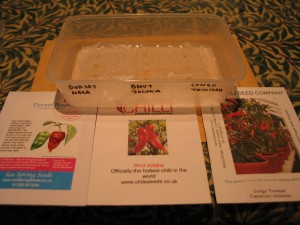 In this tray I have the famous “Dorset Naga” which has been a reliable variety over the last two seasons. Hope these seeds still germinate OK. Next is a Bhut Jolokia and to be honest I can’t remember where these seeds came from or if I have grown from this packet before, but there were only 5 seeds in the bag so they have all gone in the tray. Finally is another Habanero style called Congo Trinidad.
In this tray I have the famous “Dorset Naga” which has been a reliable variety over the last two seasons. Hope these seeds still germinate OK. Next is a Bhut Jolokia and to be honest I can’t remember where these seeds came from or if I have grown from this packet before, but there were only 5 seeds in the bag so they have all gone in the tray. Finally is another Habanero style called Congo Trinidad.
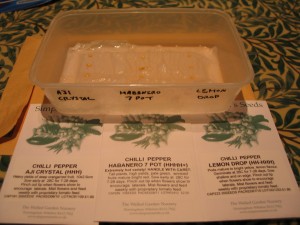 I have two varieties in this tray I also grew last year from the first time and liked them so much am growing again: Aji Crystal was quite prolific and produces big meaty chillies with a nice (but not insanely hot) kick. The Lemon Drop on the other side was also quite a good cropper and I loved the bright yellow chillies. These look great on the plate and taste yummy too – a slight citrus note. In the centre is a new variety for me this season – The Habanero 7 Pot. Called the 7 pot apparently as this is how many pots of stew one chilli will flavour! I’m really looking forward to getting these on my tongue!
I have two varieties in this tray I also grew last year from the first time and liked them so much am growing again: Aji Crystal was quite prolific and produces big meaty chillies with a nice (but not insanely hot) kick. The Lemon Drop on the other side was also quite a good cropper and I loved the bright yellow chillies. These look great on the plate and taste yummy too – a slight citrus note. In the centre is a new variety for me this season – The Habanero 7 Pot. Called the 7 pot apparently as this is how many pots of stew one chilli will flavour! I’m really looking forward to getting these on my tongue!
 Here are the “HOT Ones”… The Naga Viper held the hottest chilli world record in 2011 for a while at around 1.4million Scovilles! However within just a few days this Viper was beaten by the Trinidad Scorpion “Butch T” which was measured at just under 1.5million Scovilles. Also in this tray is a chilli called Portugal, which is a Jumbo Cayenne type. Not in the same league heat-wise as it’s 2 neighbours but I like a bit of variety.
Here are the “HOT Ones”… The Naga Viper held the hottest chilli world record in 2011 for a while at around 1.4million Scovilles! However within just a few days this Viper was beaten by the Trinidad Scorpion “Butch T” which was measured at just under 1.5million Scovilles. Also in this tray is a chilli called Portugal, which is a Jumbo Cayenne type. Not in the same league heat-wise as it’s 2 neighbours but I like a bit of variety.
 And finally, I remember growing this one a few years ago and being pleasantly surprised so I thought I’d give it another go. It’s Italian seed with a description of Peperoncino piccante tondo calabrese. It’s a round chilli that is commonly used for stuffing or in salads. I recall it having a nice punch and the plants being excellent croppers.
And finally, I remember growing this one a few years ago and being pleasantly surprised so I thought I’d give it another go. It’s Italian seed with a description of Peperoncino piccante tondo calabrese. It’s a round chilli that is commonly used for stuffing or in salads. I recall it having a nice punch and the plants being excellent croppers.
I’ll provide updates through the year as, hopefully, the seeds germinate, plants grow and bear fruit.
OT – The return of the Chillies
It’s that time of year again and hopefully I will have a better year than last for my chilli crop.
I’m not really sure what went wrong but for some reason, after potting the germinated seedlings on, they grew a little bit and then just sort of stopped growing… They didn’t die, but just didn’t any bigger. So last year I didn’t really get a harvest at all.
Anyway. It’s a new year and I have several new varieties to try so today I have selected eight and set them off to germinate in the airing cupboard.
My choices for this year are (from top left clockwise): The Black Naga, The Dorset Naga, Goat Horn, Lemon Drop, Aji Crystal, Caribbean Red Hot, Naga Jolokia, Bangalore Tornado.
All of these are what most people would call very hot chillies. However the three Naga varieties should all be outrageously hot.
I’ve used my usual method of germination which I find is fast and more reliable compared to more traditional techniques. I place a couple of sheets of unbleached, recycled toilet paper (clean of course) into the bottom of some plastic takeaway containers. I get the paper nice and wet with some luke-warm water then gently place the seeds on top of the damp paper. I can easily get two varieties in one box. Then I put the lid on (this helps to keep the moisture in the box and stop them drying out) and stick them in the airing cupboard. I find germination usually takes place within a week to 10 days and then as soon as they sprout I move the seedlings into small pots with decent potting compost. Here’s some I prepared earlier 🙂Incidentally, I’ve recently discovered that a mate in my local pub also “likes it hot” and we have decided to hold a Naga eating challenge planned for later this year. We’ll probably try and record it and put it on Youtube.
OT: Quick update on the Chillies
It’s just over 5 weeks since my Chilli seeds were removed from their packets and started off in the airing cupboard.
A few people have kindly enquired about their current status. Here’s a few pictures…
There haven’t been any major dramas and although the rather dull light we had through February hasn’t been ideal the plants seem to be doing fine. Our greenhouse is now clean and I noticed recently the automatic windows starting to lift after some prolonged sun so shortly they will start getting taken out during sunny days, but returned when it gets cold.
The next update will probably after potting-on.
OT: The Chilli Planting Begins
It’s that time already. Gosh how the time flies when you’re having fun.
This morning, following the great success with last year’s germinations, I have sown the seeds for this year’s Chilli harvest.
This year I had to be a bit ruthless. I have more varieties to choose from than this but limited greenhouse capacity so I’ve gone for a mix of strengths, sizes and tastes. There’s (clockwise from the top left):- Portugal, a Jumbo Cayenne type that sounds great,
- the now [in]famous Dorset Naga, probably the hottest Chilli in the world,
- a Jalapeño which my wife bought for me, and as these are quite mild will be good for the family,
- Thai Mound, a very hot and tiny birds-eye type,
- Fatalii which are a yellow Habanero style that has a good reputation for flavour (citrus) and also for overwintering well,
- and finally a regular Cayenne chilli which my Sister-in-law very kindly gave to me at Christmas with a copy of the Grow Your Own garden magazine.
I used the same technique as last year. That is take a small plastic tub (the kind we get Indian and Chinese Takeaways in round here), lay a sheet of absorbent kitchen paper (we use recycled, non-perfumed and unbleached paper) in the bottom and then dampen liberally with tepid water. When I say liberally, the paper is pretty much saturated and there is small amount of water that will collect in the corner of the tub if you tip it up a bit. I then write on the side of the tray the two varieties I will sow in the box and then just lay the seeds on the moist paper keeping a decent distance between them.
Here’s one I prepared earlier 🙂
I repeated this exercise with the other chillies, and some tomato seeds to try and give them a head start too. Once the seeds are sown, I put the lids on the tubs and put them in our airing cupboard. Last year germination was really quick compared to the more traditional pot sown seeds I’d done in the past. The tubs need to be checked every day and as soon as the seed starts to sprout I cut a small section of the paper that the seed is on and place that in a small (3″) pot with some some good seed compost. Then they stay on our south-facing window sill in the lounge until the weather warms up enough for them to go outside.OT: The 2009 Open Sourcerer’s Chilli Harvest
This morning I collected the fruits of the chillies I started growing on the last day of January this year.
Over the last 8 months or so, they’ve gone from this:
To this:
And now they are all gathered in, apart from one Naga plant that still has 6 good but unripe Nagas which I’ve moved into our porch where it should be a little warmer. I have read that you can over-winter some varieties. I’ve not tried that before, so will try it this time.
I had a pretty good crop overall. The Habanero Scutaba was the most prolific cropper but not as hot as I would have liked although they are quite variable. I will be drying the large ones and eating/freezing the smaller.
The regular Habanero produced an admirable crop of very hot chillies from just one plant whereas the Congo Trinidad failed to impress with regards to production. I haven’t tried them yet so can’t comment on their strength.
The small Nepali Orange and the Zimbabwe Bird Pepper are both quite hot and cropped well. Most of these have gone in the freezer.
The Naga Jolokia, although not having produced that many fruits (I have eaten about 5 or 6 of them already) are really quite astonishingly hot. I’ve never eaten anything anywhere near this hot before. Simply amazing…
Next year I will be pinching out the growing tip of the plants when they reach about 8 inches or so. Seeing commercially produced plants that are much more compact and yet have an abundance of fruit is clearly the way to go. Mine were quite “airy” and tall. I think a more compact form seems to suit them better.
I need to say many thanks to my darling wife for watering my plants when I forgot and for putting up with half of our total greenhouse capacity being taken over by Chillies. Another reason for going for the nipping-the-growing-tip method which I will try next year.






